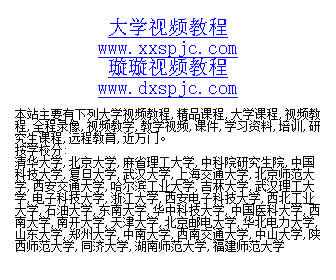中文名称:领导艺术的中心规现
英文名称:Principle-Centered Leadership
资源类型:MP3
发行时间:1992年
地区:美国
语言:英语
简介:
![《领导艺术的中心规现》(Principle-Centered Leadership)[MP3]](http://pic.dxspjc.com/dx_pic/2005082803/20050828032211321.jpg)
你听过《成功人士的7个习惯》吧?这是其作者的另一力作,具体的我就不多说了,看下面的英文吧,我就不翻译了。
这就是有声书,我找不到它的文本,有人有的话PM我,我加上去就比较完整了。
Principle-Centered Leadership by Stephen R. Covey
Review by Don W. Morishita, University of Idaho
Anyone who has read any of Covey's other books such as Seven Habits of Highly Effective
People and First Things First is familiar with his belief that the four basic needs of all people is
"to live, to love, to learn and to leave a legacy. This book also follows that tenet.
The message in this book is basically a very simple one, that is leadership skills and philosophy,
like living, must be centered around principles. Although Covey frequently refers to 'changing
paradigm' and 'new paradigm', hackneyed terms that we often hear regarding change, I felt this
book has much to offer for those interested in leadership philosophy.
Principle-Centered Leadership is described as a book exploring the natural laws that govern all
of our actions and how we can align ourselves with these laws to bring true power, focus, energy,
compassion, and integrity of our lives. In other words, it’s a book that reinforces and/or teaches
you the importance of living your life and your leadership with a solid set of moral principles.
Covey quotes an unnamed Japanese industrialist who stated, "Leadership is the art of mobilizing
and energizing the intellectual creative resources of all the people in the organization."
Covey describes 10 common dilemmas of organizations by presenting them as questions to the
reader:
1. How do we achieve a wise renewing balance between work and family?
2. How do we unleash the creativity, talent, and energy of the majority of the workforce
whose jobs neither require nor allow such use?
3. How do we create team spirit and harmony among departments and people who have
been criticizing and attacking each other for years while contending for scarce resources?
How to have peace and harmony?
4. How can we realize the choice between tough management and soft management that is
transcended by a management that is both tough and soft?
5. How can we have a culture characterized by change, flexibility, and continuous
improvement and still maintain a sense of stability and security?
6. How do we get people aligned with strategy so that everyone is committee to the strategy
as those who came up with it? How do we create ownership?
7. How can all people at all levels of organization internalize the principles of total quality
when they are so cynical, fatigued, and disillusioned from dealing with all of the past
programs?
8. How can we create a complementary team based on mutual respect when so few value
diversity and pluralism? Prejudice is pre-judgment.
9. How do we turn a mission statement into a constitution, the supreme guiding force of an
organization so that it has actual effect on a day-by-day basis? 10. How do we maintain control and yet give people freedom and autonomy that they really
need in order to be effective in their work?
He does not specifically address each of the dilemmas, which is a shame, because I was looking
for more direct answers to these questions.
Covey also describes four levels of natural laws: a) personal,
![《领导艺术的中心规现》(Principle-Centered Leadership)[MP3]](/images/emot/cool.gif) interpersonal, c) managerial, and
interpersonal, c) managerial, andd) organizational as the heart of the principle-centered leadership paradigm.
Each level of the natural laws has key principles.
Personal- trustworthiness
Interpersonal- trust
Managerial- empowerment
Organizational- alignment
It is important to work with all of the natural laws principles. All of these natural laws are
interdependent and must be practiced together, not individually.
Gandhi is quoted as saying "A person cannot do right in one department of life while attempting to
do wrong in another department. Life is one indivisible whole."
Covey finally describes how principle-centered leadership evolved from other leadership forms
(paradigms as he calls them), such as:
1. Authoritarian leadership or management, which is probably the oldest style of leadership.
2. Human relationship management came into being sometime during the 1930s. It is a
benevolent form of leadership, where people are treated with kindness, respect, and
dignity. It is still the dominant management style in most organizations.
3. Human resource management began around 1960. It built upon human relationship
management and addresses how people are not only treated, but how they are developed
and how they are used.
4. Principle-centered leadership sees people in the whole sense (body, mind, and spirit). It
builds upon human relationship and human resource management and further tries to
understand what gives people meaning and what gives them a sense that their lives matter.
I'd recommend this book as a good leadership philosophy. If touchy-feely is not in your
personality profile, it may not be the book for you. However, I don't consider myself a
touch-feely person and I got a lot out of it.

